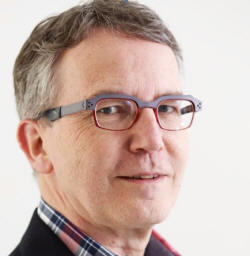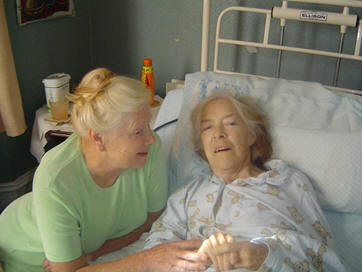Catholic Medical Quarterly Volume 65(4) November 2015
Fewer cases of euthanasia by proper palliative care
Paul Lieverse, anaesthesiologist and pain specialist,
Chair of
Christian Medical Fellowship, Netherlands
 There
will be fewer cases of euthanasia if there is sufficient access to good
palliative care. I defend this position based on my experience as a pain
specialist working in a Dutch teaching hospital for cancer patients for 25
years now.
There
will be fewer cases of euthanasia if there is sufficient access to good
palliative care. I defend this position based on my experience as a pain
specialist working in a Dutch teaching hospital for cancer patients for 25
years now.
Palliative care
Palliative care involves a comprehensive view of the needs of a patient. Not only physical complaints but also other problems. And those of their neighbours, who are sometimes going through a rough period.Palliative care has benefitted much from two developments. Firstly, it became more accepted to discuss end-of-life, ending a major taboo. Secondly, there have been major developments in palliative medicine, combining the principle of ‘everybody matters up to and including his or her death’ with practical methods for shaping such care.
While palliative care was developed in countries like the UK and Canada, it was viewed in The Netherlands as a ‘hobby’ of a minority who couldn’t reconcile themselves with euthanasia as a modern type of assisted dying. For a long time, palliative care had to fight the image of being soft and non-realistic.
Early experiences with euthanasia in The Netherlands
Education in palliative care was substandard but is catching up now. Today it is possible for caregivers to get help from consultative teams, but the number of requests is rather low or one waits till a crisis situation is in place. Not surprisingly, people fear a painful and upsetting end of life. This is enhanced by the image that you will either die with awful pains and other discomfort or choose euthanasia.
The way of dying changed the last few decades. There were great gains in survival rates for cardiovascular diseases and traffic accidents by improvements in medicine. Longer survival also imply more discomfort, and more deaths in intensive care units. People began to doubt whether medicine had brought only benefits. It became less obvious to respect life.
Some physicians began to give an overdose of a drug to their terminally ill patient on his request to make him pass away immediately. A couple of physicians provoked lawsuits aiming at a review of this practice but also at influencing public opinion. The lawsuits against some physicians who practiced euthanasia resulted in the so-called due ‘diligence requirements’. These rules included that requests must be made voluntarily, and it should concern an incurable disease causing unbearable suffering. Surveys showed broad support for ending somebody’s life in such cases. People who voiced a contrary opinion were qualified as ‘unmerciful’.
Situation after implementing the Euthanasia Law
The 2002 Euthanasia Law was therefore mainly a confirmation of the established practice. Formally euthanasia is not legalized, but the perception in The Netherlands is totally different. Since then there has been an explosion in the number of cases. The number of euthanasia cases rose from less than 2000 cases a year in 2006 by 15% annually to almost 5000 cases a year. Euthanasia has become a normal way of dying for patients with cancer.
Physicians show increasing concern, because they are now confronted with a desire for euthanasia on the basis of suffering which they cannot characterize as unbearable. Sometimes there seems to be pressure from the family. The existence of a ‘slippery slope’ is also shown by the shift in indications. Especially ‘being finished with life’ became an indication for euthanasia. This means that elderly who have a death wish but do not experience ‘unbearable suffering’ according to the original intend of the law, should be able to get assisted suicide. This happens in hundreds of cases each year.
The end-of-life clinic and other recent developments
The end-of-life clinic works with a network of teams who perform house visits to euthanize people whose own doctor wouldn’t go along with the request. Especially people who consider themselves finished with their life find their way to the end-of-life clinic.
This includes people who are elderly, lonely, who have lost their partner, who are bored.
The number of people with dementia who received euthanasia has doubled from 22 in 2011 to 42 in 2012 and again doubled to 94 in 2013.
Also, people with psychiatric problems have easier access to euthanasia. For many years the figure was around 2 per year. But in the last years it has risen to 14 in 2012 and to 42 in 2013.
New-born babies with a severe handicap are allowed to be killed, not only when they suffer, but also in view of the suffering which they have ahead.
Euthanasia and the development of palliative care
Does denial of palliative care result in a higher number of euthanasia cases? At least the order in The Netherlands has been strange; to regulate euthanasia primarily and to think about palliative possibilities only afterwards. Also, euthanasia dossiers often show a lack of palliative care – it was either unavailable or refused by the patient.
 Another
important aspect is the experience of many caregivers that providing for
palliative care and discussing it makes the desire for euthanasia fade in
many cases. This is also my personal experience. Nursing homes which
invested in good care noticed that as a positive side-effect, the number
of euthanasia requests decreased drastically.
Another
important aspect is the experience of many caregivers that providing for
palliative care and discussing it makes the desire for euthanasia fade in
many cases. This is also my personal experience. Nursing homes which
invested in good care noticed that as a positive side-effect, the number
of euthanasia requests decreased drastically.
In the meantime the Dutch public supports the right to euthanasia. A large number of physicians have difficulties with this trend, but they hesitate to express this. One doesn’t want to be considered old-fashioned. It seems that you have to defend yourself for not going along. The popular opinion nowadays is that a physician just has to go along with a request for euthanasia. Therefore quite a few physicians are secretly pleased with the end-of-life clinic. Not because they agree with the broad indications for euthanasia, but because they don’t have to deal with it themselves any longer.
In a culture in which ending somebody’s life is common practice, the palliative approach of problems faced by severely ill, disabled, elderly and people who are tired of living, becomes superfluous, as it is increasingly considered unnecessarily expensive.
